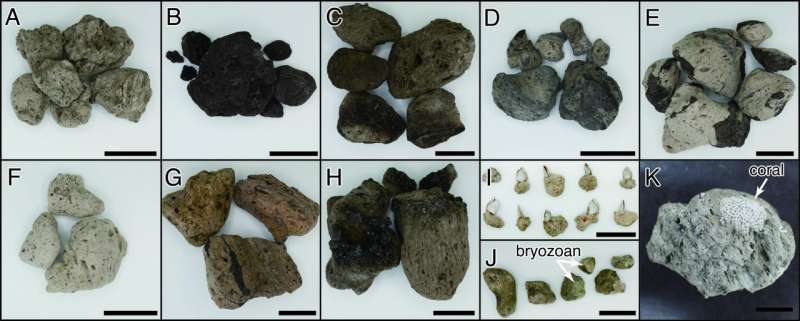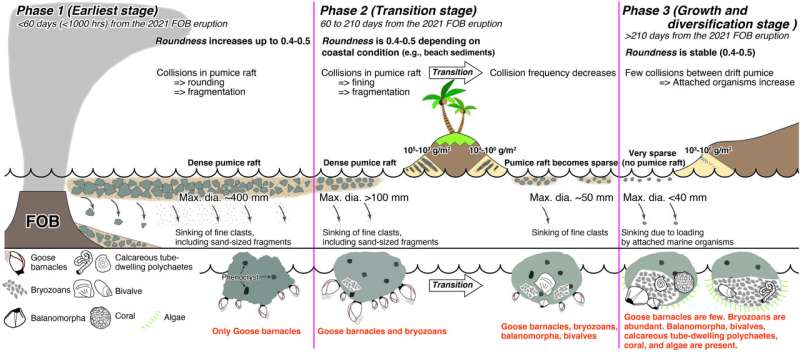This article has been reviewed according to Science X's editorial process and policies. Editors have highlighted the following attributes while ensuring the content's credibility:
fact-checked
trusted source
proofread
Scientists track evolution of pumice rafts after 2021 underwater eruption in Japan

Researchers from Tokyo Metropolitan University have carried out an unprecedentedly detailed survey of pumice rafts in the aftermath of the 2021 Fukutoku-Oka-no-Ba volcanic eruption in Japan. Using samples from 213 different locations, they considered raft density, the size and roundness of individual pumice, and biological species attached.
Their findings, published in the journal Progress in Earth and Planetary Science, reveal three phases in the evolution of drift pumice, involving rounding, fragmentation, and the diversification of attached biological organisms over time.
It is said that 85% of volcanic eruptions happen underwater. While their cousins on land might seem more vivid, the effects of underwater eruptions can be just as devastating: think shockwaves and tsunamis.
In 2021, a volcanic eruption under the sea in Fukutoku-Oka-no-Ba in Japan caused mass disruption to ports, ships, and fisheries through the vast amounts of pumice that was produced, creating enormous "pumice rafts" which floated over the sea and deposited on land.
Massive pumice raft events like this may be relatively rare, occurring once every 10 years or so, but when they do, they can have a devastating effect on everyday lives and livelihoods.
Understanding how pumice and pumice rafts evolve as they come over the sea is an important mission for scientists as they try to understand the risks and mitigate their impact on shoreline communities.
A team led by Assistant Professor Daisuke Ishimura has undertaken an unprecedentedly detailed survey of drift pumice from this event, sampled over a year from 213 different shoreline locations in Japan, Thailand, and the Philippines.
Since the eruption happened close to an archipelago, it was possible to extensively sample pumice which had washed up over the many islands over time.
They focused on the amount of deposit per area, the roundness of individual pumice, and the biological species which were found attached. Drift pumice is also known for its ability to transport species over vast distances; the researchers' data shed a rare light on when and how this can occur.

The team found that the rafts evolved over three different phases. In the first 60 days or so, pumice rafts are densely packed, leading to lots of collisions between individual pumice as they float on the sea surface. Sharp edges are shaved off, and the pumice is rapidly rounded, as shown directly from the changes in roundness of samples taken after the event.
The collisions also make it harder for organisms to attach to the pumice; only goose barnacles are found attached at this stage.
After this first phase, pumice continue to fragment and the maximum size of pumice in the rafts decreases, along with the density of the raft as smaller pumice sink. However, newly fragmented pumice clearly tends to round quickly, as the roundness of the pumice remains constant.
Bryozoans (simple aquatic invertebrates) join the goose barnacles, but the biodiversity remains relatively low. It is only in the third phase, after 210 days or so, that the biodiversity explodes. The density of pumice in the sea is now low enough that collisions are far less frequent, giving organisms like bivalves and coral a chance to make a home for themselves. This is around the time that rafts are no longer formed.
While individual aspects, like pumice becoming round in the sea, have been noted before, this is the first time that time-lapse evidence has been used to put such processes on solid ground. The team hopes their findings inform disaster mitigation efforts in the aftermath of future events.
More information: Daisuke Ishimura et al, Dispersion, fragmentation, abrasion, and organism attachment of drift pumice from the 2021 Fukutoku-Oka-no-Ba eruption in Japan, Progress in Earth and Planetary Science (2025). DOI: 10.1186/s40645-024-00678-z
Provided by Tokyo Metropolitan University





















